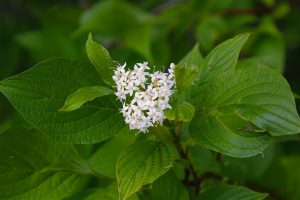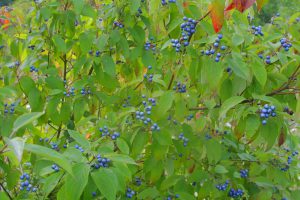Native Plant Profile: Silky Dogwood
Silky dogwood (Cornus amomum) is a medium-sized, native in the dogwood family (Cornaceae), and its blue berries are savored by many songbirds. More than 45 types of songbirds and game birds have been documented consuming the fatty berries in the fall.
Silky dogwood has simple, opposite leaves that turn a brownish-red color in the fall. The twigs are reddish to purplish-brown and contain a brown pith, which is sometimes helpful for identification. The plant reaches 10-12 feet in height and 6-10 feet in width. It can withstand full shade to full sun but needs moist or wet soils to thrive. Because of its preference for wetter areas, silky dogwood is sometimes referred to as swamp dogwood. Around June, white blooms form in clusters which are visited by a variety of bee and butterfly pollinators. The pollinated flowers turn into dark blue fruits by early September.
Silky dogwood is a host plant for the spring azure butterfly. It has also been found to support several specialist bee species in the Andrena genus. The berries’ high fat content makes them a favored food among migrating songbirds. One caution: deer also love to browse silky dogwood, so it is best not to plant this in areas with high deer densities.
Silky dogwood is susceptible to scale and infrequently can be impacted by powdery mildew, blights, borers and leaf miners.
Similar dogwood shrubs include red osier dogwood (Cornus sericea), which provide brilliant fall and winter color to landscapes as well as gray dogwood (Cornus racemosa) which sports white fruit.
Happy holidays HabiChat fans!
While I am not a big fan of wintertime, I am excited to see new visitors to my backyard.
Since winter is a great time for bird watching, much of this HabiChat is dedicated to projects and plants that will help local bird species. Learn about local research on native plants and how they help native birds, read up on evening grosbeaks and why their return to Maryland is special, learn about our native silky dogwood, and finally, keep an eye out for finch eye disease.
Winter is also a time for maintenance projects, so don’t forget to clean out and repair nest boxes and prune your shrubs and trees. Remember, water is crucial to many species this time of year. Consider adding a heated bird bath or pet water bowl to your landscape to help local wildlife. If you are looking for fun projects to do with the kids, try a winter safari or making seed wreaths.
In addition, the University of Maryland Extension’s Woodland Stewardship Education has several upcoming events that may be of interest to backyard enthusiasts. Registration for the spring session of The Woods in Your Backyard online course will be open soon. This self-paced, non-credit course runs 10 weeks from March 5-May 21, 2019, helping landowners convert lawn to natural areas and to enhance stewardship of existing natural areas.
As a final note, the Maryland Amphibian and Reptile Atlas is now available, containing information on more than 80 reptile and amphibian species. Data was collected by local biologists and nearly 1,000 community scientists. Each species is given a detailed account of identification characters, life history information, and where it was found across the state.
Happy Habitats,
Kerry Wixted
Click here to have HabiChat—the quarterly backyard wildlife habitat newsletter from the Wild Acres program—delivered right to your inbox!
In this Issue
Habitat Tips: Native Birds Need Native Plants
Loving Birds to Death & the Importance of Cleaning Feeders
Native Animal Profile: Evening Grosbeak
Native Plant Profile: Silky Dogwood




 1-888-373-7888
1-888-373-7888 233733
233733